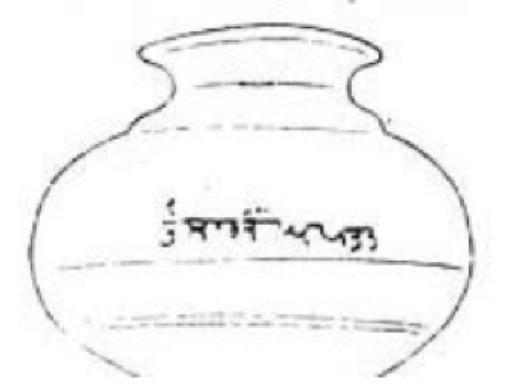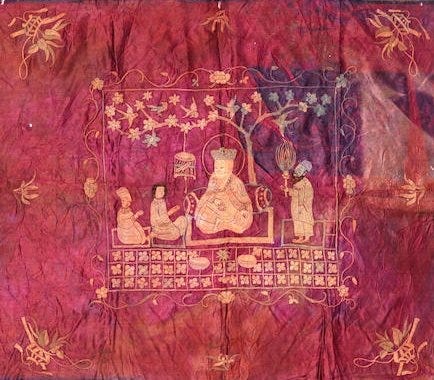Sikhs on the Silk Road
An observation of Sikh traders in different regions of the Silk Road and their influence on Sikhi.
Despite a lack of information on the subject, there is quite a large history of Sikh traders on the Silk Road, stretching from Eastern Europe to China. A large number of Sikh-related artefacts can be found across these destinations due to many Khatri merchants professing the Sikh faith. This article will only mention traders who had migrated across the Silk Road and steer clear of other occupation-based migration e.g. the policemen of Shanghai or the petty moneylenders of the Philippines.
Russia
St. Petersburg
St. Petersburg was a city established on a small Swedish town by Peter the Great, who attempted to create a port city signalling Russia’s window to the West. This city had a few Khatri traders, who had worked up the Volga river, from the southern cities of Astrakhan and Kazan. The book ‘Sikh Sampradavali’ by Piara Singh Padam helps provide evidence for Sikh establishments in St. Petersburg:
ਇਹ ਇਕ ਇਤਿਹਾਸਕ ਹਕੀਕਤ ਹੈ ਕਿ ਇਹਨਾਂ ਉਦਾਸੀ ਮਹਾਤਮਾਵਾਂ ਚਿਰੰਕਾਲ ਤਕ ਦੂਰ ਦੂਰ ਜਾ ਕੇ ਗੁਰੂ ਨਾਨਕਮਤ ਦਾ ਪ੍ਰਚਾਰ ਕੀਤਾ, ਭਾਰਤ ਵਿਚ ਹੀ ਨਹੀਂ ਬਾਹਰ ਵੀ । ਜੈਸਾ ਕਿ ਊਨ੍ਹੀਵੀ ਸਦੀ ਵਿਚ ਬਾਵਾ ਰਾਮਦਾਸ ਨੇ ਰੂਸ ਦੀ ਰਾਜਧਾਨੀ ਪੀਟਰਜ਼ਬਰਗ (ਲੈਨਿਨ ਗ੍ਰਾਡ) ਵਿਚ ਧਰਮਖ਼ਾਲਾ ਸਥਾਪਨ ਕੀਤੀ ।
It is a historical truth that these Udasi priests propagated the message of Guru Nanak far and wide, not only in India but also abroad. For example, in the nineteenth century, Bawa Ramdas established a gurudwara in the capital of Russia, St. Petersburg (Leningrad).
The British published ‘Calcutta Review’ also mentions the same Bawa Ramdas of Jhang and an Indian noble, making a journey from Amritsar to St. Petersburg. Whilst at Tbilisi and Astrakhan, he was robbed but with the help of a Russian officer, he was able to reach St. Petersburg. Unfortunately, the Indian noble died before meeting Bawa Ramdas at St. Petersburg. Accordingly, the Tsar Alexander II pitied the Udasi and summoned him to his royal court, allowing to prove his connection to the Indian noble and allowing him to inherit a crore.
Astrakhan
The city of Astrakhan is found on the northern coast of the Caspian Sea and was a large trade outpost on the northern areas of the Silk Road. It had a large concentration of Khatri traders, both Hindu and Sikh. ‘The Calcutta Review’ mentions:
The Seikhs have a shrine at Astrakhan, and another in some obscure place on the shores of the Red Sea, which the Khalsas view with the same veneration that the Christians of the middle ages viewed Jerusalem, and the Moslems of all ages have viewed Mecca and Medina.
From this quote, it is evident that Astrakhan was considered an important town for Sikh traders, viewing it as a local pilgrimage. Karam Singh Historian’s ‘Katak Ki Vaisakh’ also mentions a historical gurudwara in Astrakhan from his conversation with Bhai Gurmukh Singh of Oriental College Lahore. Astrakhan (and Bukhara) was also briefly home to Kripal Dass of Multan and Sikkar, who brought many Sikh manuscripts across the Silk Road (More on this later).
Orsk
The city of Orsk is strategically on the southern tips of the Ural Mountains, located on the present day Russia-Kazakhstan border, in the region of Siberia. The 1952-1956 number of ‘Epigraphica Vostoka’ published in Leningrad had revealed excavations undergone in Orsk and created a sketch of the unknown vessel and its inscription. In this city of Orsk, a bronze vessel with the one line inscription of ‘Bhola Singh Pandit’ in Gurmukhi was found. This helps to identify the establishment of a Sikh community, even in the smaller trading cities of Russia.

Central Asia
Afghanistan
The Sikh history in Afghanistan deserves an article of its own but one of the main reasons for its growth as a large Sikh sangat is due to its large Khatri population and continual work by Sikh missionaries. Among the first preachers in Afghanistan was Baba Khuda Singh, an ex-police officer who became a missionary, converting many Hindu Khatris to Sikhi. He had previously stayed with Baba Bir Singh of Naurangabad and then migrated upwards to Potohar, Kabul and Kandahar.
The book ‘Jiwan Baba Khuda Singh Ji’ by Giani Partap Singh, records Baba Khuda Singh’s missionary efforts, with his first convert being a local soldier, Bhai Gulab Singh:
ਭਾਈ ਗੁਲਾਬ ਸਿੰਘ ਕੁਝ ਚਿਰ ਬਾਹਦ ਨਾਮ ਅਭਿਆਸ ਕਰਕੇ ਬੜੀ ਉਚੀ ਸੁਰਤ ਤੇਂ ਪ੍ਰਪੱਕ ਅਵਸਥਾ ਵਾਲਾ ਹੋ ਗਿਆ । ਉਸ ਨੇ ਅਮੀਰ ਕਾਬਲ ਦੀ ਨੌਕਰੀ ਛਡ ਦਿਤੀ । ਸਾਧੁ ਬਣ ਕੇ ਬਾਬਾਂ ਜੀ ਨਾਲ ਅਫ਼ਗ਼ਾਨਿਸਤਾਨ ਵਿਚ ਵਿਚਰਨ ਲਗ ਪਿਆਂ।
After meditation upon naam, Bhai Gulab Singh had spiritually matured. He left his job for the Amir of Kabul. After becoming a sadhu, he travelled throughout Afghanistan with Baba Khuda Singh.
These sorts of continual interactions between Punjabis and Khatris in Afghanistan allowed for effective parchar there. Although, it should be said that Afghanistan has had a relation with Sikhs since the times of the Gurus, with Bhai Nand Lal being born in Ghazni. However, the Sikh population only became large, towards the start of the 20th century, when Akali Kaur Singh and other Singh Sabha affiliates arranged a number of Amrit Sanchars amongst the mostly Sehajdhari population; allowing for the Afghan Sikh population to grow into the large population that exists today.
Uzbekistan
Uzbekistan contains the cities of Bukhara and Samarkand, which were key cities on the Central Asian portion of the Silk Road; both being immensely important to control as key trade hubs. As mentioned before, Kripal Dass of Multan and Sikkar briefly stayed in Bukhara, as a merchant. His manuscripts were acquired by the Institute of Oriental Studies, Leningrad and reported by a Soviet scholar in 1973. These contain Gurbilas, Heer Ranjha, Hanuman Natak, Bhagwad Gita and various other Janamsakhis.
Pandit Arjun Muni’s ‘Gurdwara Darpan’ also recorded a number of gurudwaras built by Multani and Sindhi Nanakpanthis in Central Asia. These were found throughout Central Asia with notable ones in Andijan, Karmana, Samarkand and Bukhara. Bukhara was home to the biggest gurudwara out of these, owing to its large Khatri trader population. After the Russian revolution of 1917, almost if not all of the Khatri traders moved back to India.
Iran and the Caucasus
Baku
Baku is a strategic trade hub located on the western coast of the Caspian Sea. This is home to the Ateshgah of Baku, a Zoroastrian fire temple, later used by Hindus and Sikhs as a place of worship too, containing Farsi, Devanagari and Gurmukhi inscriptions. The Gurmukhi inscription starts off with the Mool Mantar and then also has an invocation to Jvala (the holy fire). A second Gurmukhi inscription also starts off the same but then refers to the disciples who built the place. It is thought the inscriptions were built by Khatri merchants, most likely from Multan.

Zahedan
The city of Zahedan is located in Iranian Balochistan, on the current-day Iranian-Pakistan border. Local folklore posits that the city of Zahedan gets its name from a visit by the Shah of Iran, who had confused the local Sikh population for zaheds or Sufi ascetics, so had renamed the town to Zahedan or the city of the Sufi ascetics. Sikh migration to this city began in the early 20th century, with Sindhis and Khatris both setting up many businesses there. One of the most influential businesses in India had its roots in Iran: the Hinduja Group; other businesses include the Hind-Iran bank.
Little is known about Sikh traders in Iran before British rule in India but there are a few references. Mountstuart Elphinstone’s ‘An Account of the Kingdom of Caubul, and Its Dependencies in Persia, Tartary, and India’ mentions how an intelligent Sikh goldsmith believed that Iranians were among the least hospitable to non-Muslims, compared to Afghans:
One Sik Goldsmith in particular (who was a very intelligent man, and had travelled over great part of Afghaunistaun, Persia, Khorassan, and Tartary), always spoke of the kindness and hospitality he received in the former country, which he contrasted with the contempt with which he was treated by the Persians, who would not allow him to draw water, for fear of polluting the well, or to walk in the streets during rain, lest he should splash some Mahomedan, and thus render him impure.
China
Xinjiang
There isn’t much written about the Khatri traders of China; the majority of Sikh history in China comes from after British occupation. However, there were a few Khatris that resided in Xinjiang, the most notable cities being Hotan, Urumqi and Kashgar. Robert Shaw, the British explorer to Central Asia and Xinjiang mentions a tired Sikh trader in his memoirs, ‘Visits to High Tartary, Yarkand, and Kashgar’:
I shall never forget that night's bivouac on the snow. As soon as the horse carrying the brush-wood fuel came up (it was past 12 o'clock at night), we two Englishmen made shift to light a fire against a rock, clearing away the snow for the purpose. Attracted by this, a Sikh merchant who was crossing the pass the same day, came and sat down with us. His long black beard and moustache were covered with pendant icicles which dragged down the hair by their weight. His face was haggard, and his only thought seemed to be of the fire. I presently found a bottle of rum, and was proceeding to uncork it, when he looked round, laid his hand on my shoulder, and said earnestly : “I am partner in that." I laughed, and gave him some, and it seemed to revive him, for he began to bewail his fate.
Tara Singh (the Sikh merchant) would accompany Robert Shaw through most of Yarkand and the Bara Lacha Pass in 1867. Many of the traders that stayed in caravanserais across Xinjiang would eventually intermarry within the local populace and some were even unable to converse in their mother tongues anymore. After the warlord, Sheng Shicai, rose to power in Xinjiang, most Sikh traders were forced to leave and left for either India or Afghanistan.
East China
Although, there were large populations of Sikhs in Shanghai, Hong Kong and other large Chinese cities, these were mostly a result of British non-trade related employment. The Sikh population in Shanghai was largely a result of Sikh police officers being hired to monitor the city. There is little to mention about the Sikh inhabitants of Hong Kong and other cities until British rule in India.
Conclusion
The role that Khatri traders played on the Silk Road allowed for the geographical transmission of Sikhi beyond India. Similar to how Christianity, Buddhism and Islam had flourished across the Silk Road, Sikhi was also able to do the same albeit to a smaller extent. Afghanistan’s Sikh minority is a result of this transmission with the Silk Road, alongside a healthy relationship with Punjab.
With the emergence of the nation state, many of these minority Sikh communities found themselves migrating back to India or in more gruesome circumstances, killed by ideological rebels. In Russia and Central Asia, Khatris left due to a brewing class conflict between themselves and local communists whereas in Afghanistan and Iran, it was due to religious fundamentalists. It is unfortunate that although Sikh heritage might remain in these trade hubs but not many Sikhs exist across the once bustling Silk Road but such is the fate of many similar trading communities e.g. Sindhis, Armenian Christians.





